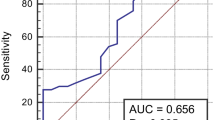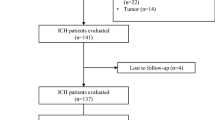Abstract
The aim of the study was to assess the 90-day prognostic value of copeptin in a group of Chinese patients with acute intracerebral hemorrhage (ICH). In this study, all consecutive patients with first-ever ICH from 2010 to 2012 were recruited to participate in the study. On admission, plasma copeptin levels were measured by enzyme-linked immunosorbent assay. The Glasgow Coma Scale (GCS) and Hemphill ICH scores were assessed on admission blinded to plasma copeptin levels. For the assessment of functional outcome at 90 days, Modified Rankin Scale was used. During the study period, 271 patients were diagnosed as ICH and were included in the analysis. The median GCS score on admission was 11 points. Patients with an unfavorable outcomes and non-survivors had significantly increased plasma copeptin levels on admission (P < 0.001 for both). Copeptin was an independent prognostic marker of functional outcome and death [odds ratio 3.45 (95 % confidence intervals: 1.85–6.99) and 3.66 (2.42–8.28), respectively, P < 0.001 for both, adjusted for age, the hematoma volume and other predictors] in patients with ICH. In receiver operating characteristic curve analysis, copeptin could improve the Hemphill score in predicting 90-day functional outcome [area under the curve (AUC) of the combined model, 0.83; 95 % CI 0.74–0.90; P < 0.001] and mortality (AUC of the combined model, 0.88; 95 % CI 0.82–0.93; P < 0.001). In conclusion, our study suggests that copeptin levels are a useful tool to predict unfavorable functional outcome and mortality 90 days after ICH and have a potential to assist clinicians.



Similar content being viewed by others
References
Andersen KK, Olsen TS, Dehlendorff C, Kammersgaard LP (2009) Hemorrhagic and ischemic strokes compared: stroke severity, mortality, and risk factors. Stroke 40:2068–2072
Alvarez-Sabin J, Delgado P, Abilleira S, Molina CA, Arenillas J et al (2004) Temporal profile of matrix metalloproteinases and their inhibitors after spontaneous intracerebral hemorrhage: relationship to clinical and radiological outcome. Stroke 35:1316–1322
Delgado P, Alvarez Sabin J, Montaner J (2007) Biological markers in spontaneous intracerebral hemorrhage. Neurologia (Barcelona, Spain) 22:448–455
Nickel CH, Bingisser R, Morgenthaler NG (2012) The role of copeptin as a diagnostic and prognostic biomarker for risk stratification in the emergency department. BMC Med 10:7
Barat C, Simpson L, Breslow E (2004) Properties of human vasopressin precursor constructs: inefficient monomer folding in the absence of copeptin as a potential contributor to diabetes insipidus. Biochemistry 43:8191–8203
Morgenthaler NG, Müller B, Struck J, Bergmann A, Redl H, Christ-Crain M (2007) Copeptin, a stable peptide of the arginine vasopressin precursor, is elevated in hemorrhagic and septic shock. Shock 28:219–226
Stoiser B, Mörtl D, Hülsmann M, Berger R, Struck J, Morgenthaler NG et al (2006) Copeptin, a fragment of the vasopressin precursor, as a novel predictor of outcome in heart failure. Eur J Clin Invest 36:771–778
Voors AA, von Haehling S, Anker SD, Hillege HL, Struck J, Hartmann O et al (2009) C-terminal provasopressin (copeptin) is a strong prognostic marker in patients with heart failure after an acute myocardial infarction: results from the OPTIMAAL study. Eur Heart J 30:1187–1194
De Marchis GM, Katan M, Weck A et al (2013) Copeptin adds prognostic information after ischemic stroke results from the CoRisk study. Neurology 80:1278–1286
Dong X, Tao DB, Wang YX et al (2013) Plasma copeptin levels in Chinese patients with acute ischemic stroke: a preliminary study. Neurol Sci 34:1591–1595
Zweifel C, Katan M, Schuetz P, Siegemund M, Morgenthaler NG, Merlo A et al (2010) Copeptin is associated with mortality and outcome in patients with acute intracerebral hemorrhage. BMC Neurol 10:34
Dong XQ, Huang M, Yu WH et al (2011) Change in plasma copeptin level after acute spontaneous basal ganglia hemorrhage. Peptides 32:253–257
Kothari RU, Brott T, Broderick JP, Barsan WG, Sauerbeck LR, Zuccarello M et al (1996) The ABCs of measuring intracerebral hemorrhage volumes. Stroke 27:1304–1305
Goldstein LB, Samsa GP, Matchar DB, Horner RD (2004) Charlson index comorbidity adjustment for ischemic stroke outcome studies. Stroke 35:1941–1945
Gill MR, Reiley DG, Green SM (2004) Interrater reliability of Glasgow Coma Scale scores in the emergency department. Ann Emerg Med 43:215–223
Bonita RBR (1988) Modification of rankin scale: recovery of motor function after stroke. Stroke 19:1497–1500
Morgenthaler NG, Struck J, Alonso C, Bergmann A (2006) Assay for the measurement of copeptin, a stable peptide derived from the precursor of vasopressin. Clin Chem 52:112–119
Zhang JL, Yin CH, Zhang Y et al (2013) Plasma copeptin and long-term outcomes in acute ischemic stroke. Acta Neurol Scand 128:372–380
Fenske W, Stork S, Blechschmidt A, Maier SG, Morgenthaler NG, Allolio B (2009) Copeptin in the differential diagnosis of hyponatremia. J Clin Endocrinol Metab 94:123–129
Katan M, Fluri F, Morgenthaler NG, Schuetz P, Zweifel C, Bingisser R, Muller K, Meckel S, Gass A, Kappos L et al (2009) Copeptin: a novel, independent prognostic marker in patients with ischemic stroke. Ann Neurol 66:799–808
Zhang A, Li J, Li X et al (2013) The prognostic value of copeptin for acute intracerebral hemorrhage patients. Exp Ther Med 5:467–470
Urwyler SA, Schuetz P, Fluri F, Morgenthaler NG, Zweifel C, Bergmann A, Bingisser R, Kappos LB, Steck AB, Engelter SB, Müller BF, Christ-Crain M, Katan M (2010) Prognostic value of copeptin: one-year outcome in patients with acute stroke. Stroke 41:1564–1567
Zhu XD, Chen JS, Zhou F et al (2011) Detection of copeptin in peripheral blood of patients with aneurysmal subarachnoid hemorrhage. Crit Care 15:R288
Delgado P, Alvarez-Sabin J, Abilleira S, Santamarina E, Purroy F, Arenillas JF, Molina CA, Fernandez-Cadenas I, Rosell A, Montaner J (2006) Plasma d-dimer predicts poor outcome after acute intracerebral hemorrhage. Neurology 67:94–98
Castillo J, Davalos A, Alvarez-Sabin J, Pumar JM, Leira R, Silva Y, Montaner J, Kase CS (2002) Molecular signatures of brain injury after intracerebral hemorrhage. Neurology 58:624–629
Delgado P, Alvarez Sabin J, Santamarina E, Molina CA, Quintana M, Rosell A, Montaner J (2006) Plasma S100B level after acute spontaneous intracerebral hemorrhage. Stroke 37:2837–2839
Gebel JM Jr, Jauch EC, Brott TG, Khoury J, Sauerbeck L, Salisbury S, Spilker J, Tomsick TA, Duldner J, Broderick JP (2002) Relative edema volume is a predictor of outcome in patients with hyperacute spontaneous intracerebral hemorrhage. Stroke 33:2636–2641
Molnar AH, Varga C, Berko A, Rojik I, Parducz A, Laszlo F, Laszlo FA (2008) Inhibitory effect of vasopressin receptor antagonist OPC-31260 on experimental brain oedema induced by global cerebral ischaemia. Acta Neurochir (Wien) 150:265–271
Delgado TJ, Arbab MAR, Warberg J, Svendgaard NA (1988) The role of vasopressin in acute cerebral vasospasm. J Neurosurg 68:266–273
Shuaib A, Wang CX, Yang T, Noor R (2002) Effects of nonpeptide V1 vasopressin receptor antagonist SR-49059 on infarction volume and recovery of function in a focal embolic stroke model. Stroke 33:3033–3037
Kozniewska E, Gadamski R, Klapczynska K, Wojda R, Rafalowska J (2008) Morphological changes in the brain during experimental hyponatremia. Do vasopressin and gender matter? Folia Neuropath 46:165–170
Kozniewska E, Romaniuk K (2008) Vasopressin in vascular regulation and water homeostasis in the brain. J Physiol Pharmacol 59(Suppl 8):109–116
Acknowledgments
All authors have contributed significantly, and that all authors are in agreement with the content of the manuscript.
Author information
Authors and Affiliations
Corresponding author
Rights and permissions
About this article
Cite this article
Wei, ZJ., Ou, YQ., Li, X. et al. The 90-day prognostic value of copeptin in acute intracerebral hemorrhage. Neurol Sci 35, 1673–1679 (2014). https://doi.org/10.1007/s10072-014-1809-2
Received:
Accepted:
Published:
Issue Date:
DOI: https://doi.org/10.1007/s10072-014-1809-2




